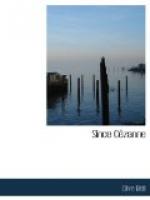Picasso is a born chef d’ecole. His is one of the most inventive minds in Europe. Invention is as clearly his supreme gift as sensibility is that of Matisse. His career has been a series of discoveries, each of which he has rapidly developed. A highly original and extremely happy conception enters his head, suggested, probably, by some odd thing he has seen. Forthwith he sets himself to analyze it and disentangle those principles that account for its peculiar happiness. He proceeds by experiment, applying his hypothesis in the most unlikely places. The significant elements of negro sculpture are found to repeat their success in the drawing of a lemon. Before long he has established what looks like an infallible method for producing an effect of which, a few months earlier, no one had so much as dreamed. This is one reason why Picasso is a born chef d’ecole. And this is why of each new phase in his art the earlier examples are apt to be the more vital and well-nourished. At the end he is approaching that formula towards which his intellectual effort tends inevitably. It is time for a new discovery.
Meanwhile a pack of hungry followers has been eyeing the young master as he made clearer and ever clearer the nature of his last. To this pack he throws hint after hint. And still the wolves pursue. You see them in knots and clusters all along the road he has travelled, gnawing, tugging at some unpicked idea. Worry! worry! worry! Here is a crowd of old laggards still lingering and snuffling over “the blue period.” A vaster concourse is scattered about the spot where the nigger’s head fell, and of these the strongest have carried off scraps for themselves, which they assimilate at leisure, lying apart; while round the trunk of Cubism is a veritable sea of swaying, struggling, ravenous creatures. The howling is terrific. But Picasso himself is already far away elaborating an idea that came to him one day as he contemplated a drawing by Ingres.
And, besides being extraordinarily inventive, Picasso is what they call “an intellectual artist.” Those who suppose that an intellectual artist is one who spends his time on his head mistake. Milton and Mantegna were intellectual artists: it may be doubted whether Caravaggio and Rostand were artists at all. An intellectual artist is one who feels first—a peculiar state of emotion being the point of departure for all works of art—and goes on to think. Obviously Picasso has a passionate sense of the significance of form; also, he can stand away from his passion and consider it; apparently in this detached mood it is that he works. In art the motive power is heat always; some drive their engines by means of boiling emotion, others by the incandescence of intellectual passion. These go forward by intense concentration on the problem; those swing with breathless precision from feeling to feeling. Sophocles, Masaccio, and Bach are intellectuals in this sense, while Shakespeare, Correggio, and Mozart trust their sensibility almost as a bird trusts its instinct. It never entered the head of a swallow to criticize its own methods; and if Mozart could not write a tune wrong, that was not because he had first tested his idea at every point, but because he was Mozart. Yet no one ever thought of going to a swallow for lessons in aviation; or, rather, Daedalus did, and we all know what came of it.




